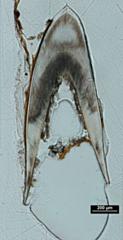Project 4903: T. Maho, R. R. Reisz. 2024. Exceptionally rapid tooth development and ontogenetic changes in the feeding apparatus of the Komodo dragon. PLOS ONE. 19 (2):e0295002.
Abstract
Dental developmental and replacement patterns in extinct amniotes have attracted a lot of attention. Notable among these are Paleozoic predatory synapsids, but also Mesozoic theropod dinosaurs, well known for having true ziphodonty, strongly serrated carinae with dentine cores within an enamel cap. The Komodo dragon, Varanus komodoensis, is the only extant terrestrial vertebrate to exhibit true ziphodonty, making it an ideal model organism for gaining new insights into the life history and feeding behaviours of theropod dinosaurs and early synapsids. We undertook a comparative dental histological analysis of this extant apex predator in combination with computed tomography of intact skulls. This study allowed us to reconstruct the dental morphology, ontogeny, and replacement patterns in the largest living lizard with known feeding behaviour, and apply our findings to extinct taxa where the behaviour is largely unknown. We discovered through computed tomography that V. komodoensis maintains up to five replacement teeth per tooth position, while histological analysis showed an exceptionally rapid formation of new teeth, every 40 days. Additionally, a dramatic ontogenetic shift in the dental morphology of V. komodoensis was also discovered, likely related to changes in feeding preferences and habitat. The juveniles have fewer dental specializations, lack true ziphodonty, are arboreal and feed mostly on insects, whereas the adults have strongly developed ziphodonty and are terrestrial apex predators with defleshing feeding behaviour. In addition, we found evidence that the ziphodont teeth of V. komodoensis have true ampullae (interdental folds for strengthening the serrations), similar to those found only in theropod dinosaurs. Comparisons with other species of Varanus and successive outgroup taxa reveal a complex pattern of dental features and adaptations, including the evolution of snake-like tongue flicking used for foraging for prey. However, only the Komodo dragon exhibits this remarkable set of dental innovations and specializations among squamates.Read the article »
Article DOI: 10.1371/journal.pone.0295002
Project DOI: 10.7934/P4903, http://dx.doi.org/10.7934/P4903
| This project contains |
|---|
Download Project SDD File |
Currently Viewing:
MorphoBank Project 4903
MorphoBank Project 4903
- Creation Date:
03 October 2023 - Publication Date:
16 November 2023
Authors' Institutions ![]()
- Jilin University
- University of Toronto
Members
| member name | taxa |
specimens |
media |
| Tea Maho Project Administrator | 6 | 9 | 32 |

